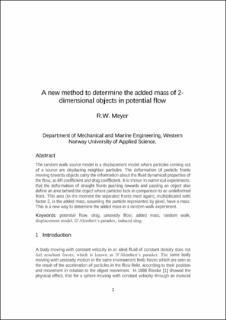A new method to determine the added mass of two- dimensional objects in potential flow.
| dc.contributor.author | Meyer, Runald Walter | |
| dc.date.accessioned | 2023-03-23T14:17:25Z | |
| dc.date.available | 2023-03-23T14:17:25Z | |
| dc.date.created | 2023-01-26T10:50:55Z | |
| dc.date.issued | 2022 | |
| dc.identifier.issn | 1759-3433 | |
| dc.identifier.uri | https://hdl.handle.net/11250/3060199 | |
| dc.description.abstract | The random walk source model is a displacement model where particles coming out of a source are displacing neighbor particles. The deformation of particle fronts moving towards objects carry the information about the fluid dynamical properties of the flow, as lift coefficient and drag coefficient. It is shown in numerical experiments, that the deformation of straight fronts pushing towards and passing an object also define an area behind the object where particles lack in comparison to an undeformed front. This aera (in the moment the separated fronts meet again), multiplicated with factor 2, is the added mass, assuming the particle represented by pixel, have a mass. This is a new way to determine the added mass in a random walk experiment. | en_US |
| dc.language.iso | eng | en_US |
| dc.publisher | Civil-Comp | en_US |
| dc.title | A new method to determine the added mass of two- dimensional objects in potential flow. | en_US |
| dc.type | Peer reviewed | en_US |
| dc.type | Journal article | en_US |
| dc.description.version | acceptedVersion | en_US |
| dc.source.volume | CCC | en_US |
| dc.source.journal | Civil-Comp Proceedings | en_US |
| dc.source.issue | 2 | en_US |
| dc.identifier.doi | 10.4203/ccc.2.2.9 | |
| dc.identifier.cristin | 2115438 | |
| cristin.ispublished | true | |
| cristin.fulltext | postprint | |
| cristin.qualitycode | 1 |
Tilhørende fil(er)
Denne innførselen finnes i følgende samling(er)
-
Import fra CRIStin [3604]
-
Institutt for maskin- og marinfag [363]
